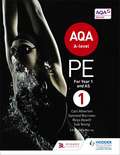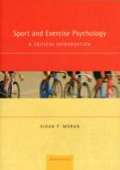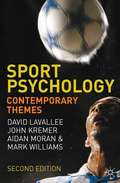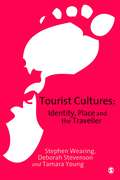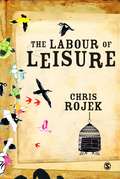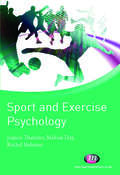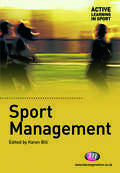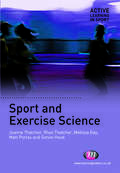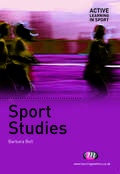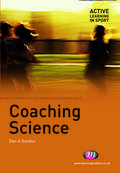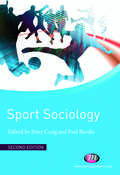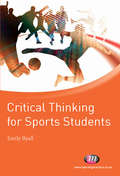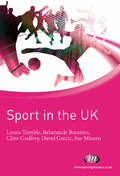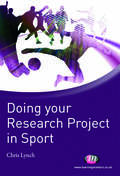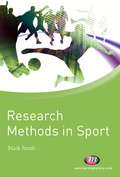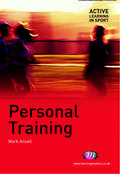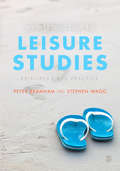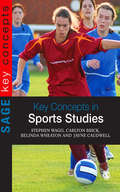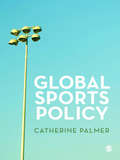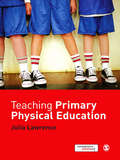- Table View
- List View
Cricket Player with Bowling and Batting Ends (large print)
by RnibThere are three images on this page: a cricket bat and ball, a player bowling, and a plan view of the bowling and batting ends of the pitch. Each one is surrounded by a dashed line image border. There is a locator dot shown, which will be at the top left of the page when the image is the correct way up. The cricket bat and ball can be found at the top left of the page. The bat is seen from the front in a horizontal position with the blade of the bat to the left and the handle to the right. The ball can be found down the page from the bat's handle. The player is bowling is in the bottom left of the page. He is seen from the side and faces right so that only one eye and ear can be found. His head is just above the centre of the image. To the left of this he has one arm held up. Down the page is his body and to the right of this his bowling arm is held out to the right, having just released the ball up and to the right. Down from this arm, one of the stumps can be found and to the left of this is one of the player's legs, bent at the knee with a foot on the ground at the bottom of the image. Left of this is his other leg, bent at the knee with its foot off the ground. The diagram of the pitch ends is on the right of the page. The various pitch markings are shown and labelled, with a key to the abbreviations used in the centre of the image. The bowling end is in the top of the image and the batting end, with a top view of a batsman up from the wicket, at the bottom. The part of the pitch between the ends has not been shown because of space limitations. The length of the pitch, from wicket to wicket, is 22 yards (20.12 metres).
Air Pistol Ten Metres (UEB uncontracted)
by RnibThis page has three images on it: an air pistol, a shooting target and an Olympic air pistol contestant taking aim. Each image has a dashed line image border. There is a locator dot shown, which will be at the top left of the page when the image is the right way up. Air pistol (top left): This is an image of an air pistol, seen from the side and pointing right. The grip of the pistol is to the left of the image. To the right of this are the trigger, and the barrel extending to the right of the image with the front sight on the far right. Down the page from the barrel is the gas cylinder, which contains the C-O 2 that powers the gun. Shooting target (bottom left): This is an image of a 10-metre air pistol shooting target at full size. Part of the target on the left and at the top has not been shown because of space considerations. There are eleven concentric circles. The scores go from 1 for the outermost ring to 10.9 for the innermost. They are marked in print numerals from 8 to 1, starting at the fourth ring from the centre and going vertically and horizontally to the outer ring. Olympic air pistol contestant (right): The contestant is facing forward with his head facing to the left. His head is in the top right of the page with his torso down the page. One arm is stretched out to the left with his hand holding an air pistol pointing to the left. His other arm hangs down to the right of his body. His legs go down the page from his body to his feet on the ground at the bottom of the page. He is wearing a tracksuit and a peaked baseball cap.
Air Pistol Ten Metres (large print)
by RnibThis page has three images on it: an air pistol, a shooting target and an Olympic air pistol contestant taking aim. Each image has a dashed line image border. There is a locator dot shown, which will be at the top left of the page when the image is the right way up. Air pistol (top left): This is an image of an air pistol, seen from the side and pointing right. The grip of the pistol is to the left of the image. To the right of this are the trigger, and the barrel extending to the right of the image with the front sight on the far right. Down the page from the barrel is the gas cylinder, which contains the C-O 2 that powers the gun. Shooting target (bottom left): This is an image of a 10-metre air pistol shooting target at full size. Part of the target on the left and at the top has not been shown because of space considerations. There are eleven concentric circles. The scores go from 1 for the outermost ring to 10.9 for the innermost. They are marked in print numerals from 8 to 1, starting at the fourth ring from the centre and going vertically and horizontally to the outer ring. Olympic air pistol contestant (right): The contestant is facing forward with his head facing to the left. His head is in the top right of the page with his torso down the page. One arm is stretched out to the left with his hand holding an air pistol pointing to the left. His other arm hangs down to the right of his body. His legs go down the page from his body to his feet on the ground at the bottom of the page. He is wearing a tracksuit and a peaked baseball cap.
Air Pistol Ten Metres (UEB contracted)
by RnibThis page has three images on it: an air pistol, a shooting target and an Olympic air pistol contestant taking aim. Each image has a dashed line image border. There is a locator dot shown, which will be at the top left of the page when the image is the right way up. Air pistol (top left): This is an image of an air pistol, seen from the side and pointing right. The grip of the pistol is to the left of the image. To the right of this are the trigger, and the barrel extending to the right of the image with the front sight on the far right. Down the page from the barrel is the gas cylinder, which contains the C-O 2 that powers the gun. Shooting target (bottom left): This is an image of a 10-metre air pistol shooting target at full size. Part of the target on the left and at the top has not been shown because of space considerations. There are eleven concentric circles. The scores go from 1 for the outermost ring to 10.9 for the innermost. They are marked in print numerals from 8 to 1, starting at the fourth ring from the centre and going vertically and horizontally to the outer ring. Olympic air pistol contestant (right): The contestant is facing forward with his head facing to the left. His head is in the top right of the page with his torso down the page. One arm is stretched out to the left with his hand holding an air pistol pointing to the left. His other arm hangs down to the right of his body. His legs go down the page from his body to his feet on the ground at the bottom of the page. He is wearing a tracksuit and a peaked baseball cap.
AQA A-level PE Book 1: For A-level year 1 and AS (PDF)
by Carl Atherton Symond Burrows Ross Howitt Sue YoungInspire, motivate and give confidence to your students with AQA PE for A Level Book 1. This reliable and accessible textbook will offer your students comprehensive support for both the academic and practical elements of the course. This Student's Book has been selected for AQA's official approval process. - Key questions to direct thinking and help students focus on the key points - Diagrams to aid understanding - Summaries to aid revision and help students access the main points - Extension questions, stimulus material and suggestions for further reading to stretch, challenge and encourage independent thinking and a deeper understanding - Definition of key terms - again to aid and consolidate understanding of technical vocabulary and concepts - Activities to build conceptual understanding and sound knowledge and understanding, analysis, evaluation and application skills Contents: Section 1 Applied Anatomy and Physiology 1. 1 The cardiovascular system (Sue Young) 1. 2 The respiratory system (Sue Young) 1. 3 The neuromuscular system (Sue Young) 1. 4 The musco-skeletal system and analysis of movement in physical activities (Sue Young) Section 2 Skill acquisition 2. 1 Skill acquisition (Carl Atherton) 2. 2 Principles and theories of learning and performance (Carl Atherton) Section 3 Sport and society 3. 1 Emergence of globalization of sport in the 21st century (Symond Burrows) 3. 2 The impact of sport on society and of society on sport (Symond Burrows) Section 4 Exercise physiology 4. 1 Diet and nutrition and their effect on physical activity and performance (Sue Young) 4. 2 Preparation and training methods in relation to maintaining physical activity and performance (Sue Young) Section 5 Biomechanical movement 5. 1 Biomechancial principles and levers (Sue Young) Section 6 Sport psychology 6. 1 Physiological influences on the individual (Carl Atherton) 6. 2Further psychological effects on the individual (Carl Atherton) 6. 3 Psychological influences on the team (Carl Atherton) Section 7 The role of technology in physical activity and sport 7. 1 The role of technology in physical activity and sport (Symond Burrows) Section 8 Assessment 8. 1 Tackling the AS exam (Ross Howitt) 8. 2 Tackling the non-examined assessment (Ross Howitt) 9781471859571
Sport And Exercise Psychology: A Critical Introduction
by Aiden P. MoranAlthough sport is played with the body, it is won in the mind. Inspired by this idea, the second edition of this popular textbook provides a comprehensive critical introduction to sport and exercise psychology - a discipline that is concerned with the theory and practice of helping athletes to do their best when it matters the most. The book is organized into four sections. Part one investigates the nature, foundations and current status of the discipline. Part two reviews the latest research findings on motivation, anxiety, concentration, mental imagery and expertise in athletes. Part three examines group processes and team dynamics. Finally, part four explores exercise behaviour and the psychology of injury rehabilitation. Each chapter contains specially designed critical thinking exercises to encourage the student to explore the deeper issues, and also features an invaluable list of suggestions for independent research projects by students. The text has been extensively re-written and updated with new material to take account of hot topics such as neuroscience and motor imagery, as well as issues such as 'grunting' in tennis, the psychology of penalty shootouts, mindfulness training as a concentration technique, the effects of music on physical activity, and 'exer-gaming' - the use of computer games to increase physical activity and exercise. Written in a lively, accessible style, the book is brimful of vivid contemporary examples and insights from the world's leading athletes, to provide a compelling bridge between theory and practice for undergraduate and postgraduate students of sport psychology, health psychology, sport science, physical education, kinesiology and leisure management. Instructors who adopt the book will be able to access a wealth of online teaching resources.
Sport And Exercise Psychology: A Critical Introduction (PDF)
by Aiden P. MoranAlthough sport is played with the body, it is won in the mind. Inspired by this idea, the second edition of this popular textbook provides a comprehensive critical introduction to sport and exercise psychology - a discipline that is concerned with the theory and practice of helping athletes to do their best when it matters the most. The book is organized into four sections. Part one investigates the nature, foundations and current status of the discipline. Part two reviews the latest research findings on motivation, anxiety, concentration, mental imagery and expertise in athletes. Part three examines group processes and team dynamics. Finally, part four explores exercise behaviour and the psychology of injury rehabilitation. Each chapter contains specially designed critical thinking exercises to encourage the student to explore the deeper issues, and also features an invaluable list of suggestions for independent research projects by students. The text has been extensively re-written and updated with new material to take account of hot topics such as neuroscience and motor imagery, as well as issues such as 'grunting' in tennis, the psychology of penalty shootouts, mindfulness training as a concentration technique, the effects of music on physical activity, and 'exer-gaming' - the use of computer games to increase physical activity and exercise. Written in a lively, accessible style, the book is brimful of vivid contemporary examples and insights from the world's leading athletes, to provide a compelling bridge between theory and practice for undergraduate and postgraduate students of sport psychology, health psychology, sport science, physical education, kinesiology and leisure management. Instructors who adopt the book will be able to access a wealth of online teaching resources.
Sport Psychology: Contemporary Themes (PDF)
by David Lavallee John Kremer Aidan Moran Mark WilliamsSport Psychology is an essential introduction to the field's key issues, suitable for psychology, sport science and sport studies students at all levels. Encompassing the history of sport psychology to more recent distinctions between sport and exercise psychology, it is ideal reading for students looking to learn about issues such as motivation, concentration and anxiety and the connection between physical activity and psychological well-being. This new edition provides updated case studies, guidance on further reading, study questions and brand new content on self-harm in sport and metaimagery. Real-life examples put the theory into practice, and the authors' focus on the freshest theories shows how the discipline has evolved in recent years.
Tourist Cultures: Identity, Place and the Traveller (PDF)
by Stephen Wearing Dr Tamara Young Dr Deborah Stevenson"This is a timely and easily accessible book that addresses a number of issues that are of central concern to the development of tourism studies. It will also be of interest to those in cultural studies, social geography and social anthropology who are concerned with the relationship between the production and consumption of place." - Kevin Meethan, University of Plymouth Sharp and engaging, Tourist Cultures presents valuable critical insights into tourism - arguing that within the imagined-real spaces of the traveller self it becomes possible to envisage tourist cultures and futures that will both empower and engage. Here is a framework for understanding tourism which is subject-centred, dynamic, and capable of dealing with the complexity of contemporary tourist cultures. The book argues that tourists are not passive consumers of either destinations or their interpretations. Rather, they are actively occupied in a multi-sensory, embodied experience. It delves into what tourists are looking for when they travel, be they on a package tour, or immersing themselves in the places, cultures and lifestyles of the exotic. Tourism is examined through a consideration of the spaces and selves of travel, exploring the cultures of meaning, mobilities and engagement that frame and define the tourist experience and traveller identities. This book draws on the explanatory traditions of sociology, human geography and tourism studies to provide useful insights into the experiential and the lived dimensions of tourism and travel. Written in an accessible and engaging style, this is a welcome contribution to the growing literature on tourism and will be important reading for students in a range of social science and humanities courses.
The Labour of Leisure: The Culture of Free Time (PDF)
by Chris RojekLeisure has always been associated with freedom, choice and flexibility. The week-end and vacations were celebrated as 'time off'. In his compelling new book, Chris Rojek turns this shibboleth on its head to demonstrate how leisure has become a form of labour. Modern men and women are required to be competent, relevant and credible, not only in the work place but with their mates, children, parents and communities. The requisite empathy for others, socially acceptable values and correct forms of self-presentation demand work. Much of this work is concentrated in non-work activity, compromising traditional connections between leisure and freedom. Ranging widely from an analysis of the inflated aspirations of the leisure society thesis to the culture of deception that permeates leisure choice, Rojek shows how leisure is inextricably linked to emotional labour and intelligence. It is now a school for life. In challenging the orthodox understandings of freedom and free time, The Labour of Leisure sets out an indispensable new approach to the meaning of leisure. Chris Rojek is Professor of Sociology and Culture at Brunel University. In 2003 he was awarded the Allen V. Sapora Award for outstanding achievement in the field of leisure studies.
Sport and Exercise Psychology
by Dr Joanne Thatcher Mrs Rachel Rahman Ms Mel DayElectronic Inspection Copy available for instructors here This is a comprehensive and accessible text on exercise and sport psychology for students on sport science/sport and exercise science degrees. It adopts an integrated, thematic approach and covers all the required theory, concepts and research, accompanied by case studies to illustrate the applied nature of the material being covered. The book is split into two major sections, covering exercise psychology and sport psychology, and each chapter supports students as they progress from clear introductory material to more advanced discussions.
Sport Management
by Karen BillThis is a core text for all those on Sport Management and Sports Studies courses. It examines both traditional business elements and the new functional areas of management in sport. Key chapters on marketing, finance, entrepreneurship, and event management are included, and the book as a whole provides a critical understanding of the complex and dynamic relationship between sport, business and management. The reader is supported through accessible theoretical explanation, real-life examples and case studies, learning activities and guidance on further study.
Sport and Exercise Science (PDF)
by Rhys Thatcher Ms Mel Day Mr Simon Hood Mr Matthew Portas Dr Joanne ThatcherThis text introduces students to the essentials of the major contributing disciplines – biomechanics, physiology and psychology. It provides detailed knowledge and understanding of each subject area combined with explicit advice on how to study effectively, research further and think critically. Case studies clearly relate theory to practice and learning exercises support readers throughout the text.
Sport Studies
by Dr Barbara Bell"A comprehensive, useful and informative practical book that draws from a range of disciplines. In particular, the learning activities provides some useful group and reflective discussions." - Heather Allison, London Metropolitan University "This book supports our year undergraduate students. The case studies and links with UK programmes provides relevant information to discuss and investigate. Easily accessible." - Emerick Kaitell, Roehampton University This is an accessible and comprehensive introductory textbook for students on sport studies courses. It brings together perspectives drawn from a range of disciplines, especially sociology, history and philosophy, with detailed information on the key political, legal, economic and vocational issues relating to sport. Written specifically for students based in the UK, the text examines the full range of topics relevant to sport studies and is fully supported with learning activities, suggestions for further study, and guidance on how to progress and succeed in the subject.
Coaching Science
by Dan GordonCoaching is an increasingly important area of sports science courses, and this text provides accessible and up-to-date coverage of this key topic. Modern coaches need to be applied scientists who keep abreast of research and are able to apply a multidisciplinary understanding to their practice. The book therefore examines coaching in terms of biomechanics, physiology and psychology, as well as perennial issues such as athlete motivation, nutrition, design of training programmes, talent identification, monitoring and ethics. Written by an author who combines academic expertise with high-level practical experience, the book successfully links theory with case studies.
Sport Sociology
by Paul Beedie Peter Craig"A welcome addition for those who teach sports studies... Used as a primer, this book provides readers with excellent introduction to the key sociological concepts, methods, and theories, and, also offers useful examples and contextualised discussions that beginners to the realm of sociology will no doubt appreciate. Beedie has compiled for students a good companion text that could certainly be used in conjunction with more detailed books, and, to guide students through more complex academic texts. Students have certainly appreciated Beedie's efforts to help them apply sociological rigour to analysing their sporting worlds, identities and experiences." - Geoffery Kohe, Worcester University "This should be highly useful for any sports studies students who are encountering the sociology of sport for the first time, even those who have previously studied sociology." - Alison Cain, Hertfordshire University Sociology is central to the study of sport in higher education. This reader-friendly textbook introduces all of the subject’s core themes, such as power, diversity and mediation, and relates them to major contemporary social issues such as commercialisation and globalisation. Special emphasis is given throughout to examples drawn from the UK and to the significance of the 2012 Olympics. Theoretical explanation is fully supported by case studies, practical and reflective exercises and guidance on further study.
Critical Thinking for Sports Students
by Emily Ryall"A really useful textbook to help undergraduate students construct arguments in their writing, and raise their writing abilities to a higher level. The book also provides useful examples that relates to sports students." - Hassan Khalil, Hertfordshire University "A fantastic text and one we use regularly with undergraduate and postgraduates." - Abbe Brady, Gloucestershire University The capacity to think critically is essential for success in sport courses in higher education. This book provides all those involved in the study of sport with the tools to assess, construct and present arguments and to analyse and evaluate material. The emphasis is on the application of critical thinking – in the form of written arguments, discussion and negotiation. Throughout, the text and examples are presented within the context of sport, helping students to more easily apply their learning to their subject area.
Sport in the UK
by Clint Godfrey David Grecic Dr Susan Minten Leona Trimble Woobae LeeThis is a comprehensive introduction for HE students to the provision, organisation, and governance of sport in the UK. Supported by case study material, it introduces the reader to key government policies, and to the ways in which public, private and voluntary sectors provide sporting opportunities. The book focuses on issues of participation, employment, media coverage and commercialisation, and critically examines them in light of the key themes of equality and diversity. Pedagogical features – learning outcomes and learning activities – help students develop an active approach to the study of sport in the UK.
Doing your Research Project in Sport
by Chris LynchThe research project is a major component of most higher education sport courses. While undertaking a research project can be an exciting and rewarding experience, it can all too easily lead to stress and disappointment. Mistakes made early in the process – in the design of experiments, for example – can lead to frustration later on. This accessible book guides students through the process, from the initial stages of research (identifying problems and designing questions) right through to the presentation of their findings.
Research Methods in Sport
by Mark SmithThis book is a comprehensive resource for all those studying sport at college or university. It covers qualitative and quantitative methods, and explains what research is, how to conduct a systematic review, and how to select, apply and combine research methods.The reader is supported throughout by learning activities, real-life examples and advice on further study.
Personal Training
by Mark AnsellThis is a key text for all those on sport science courses. It covers all the essential areas for a study of personal training including fitness testing, nutrition, psychology, training principles, health and fitness, training in different contexts and business issues. Students therefore gain all the required multi-disciplinary knowledge with an understanding of how to apply this in practice. Throughout the text, theoretical explanation is supported by case studies, practical and reflective exercises and guidance on further study.
An Introduction to Leisure Studies: Principles and Practice
by Dr Peter Bramham Stephen Wagg"There are textbooks galore, but there aren’t many crafted as intelligently as this one. This book will change the way that students understand leisure. It will give them an easier entry to that place where difficult ideas fuse into something intelligible, where real understanding sits and the educated imagination is stirred." - Tony Blackshaw, Sheffield Hallam University Peter Bramham and Stephen Wagg provide a foundation for those studying within the broad field of leisure studies. The book gives students an accessible and engaging introduction to leisure studies and leisure research, encouraging students to engage in reflexive analysis of their common sense understandings of everyday life and enabling them to develop an understanding of contemporary leisure studies and changing leisure practices.
Key Concepts in Sports Studies
by Belinda Wheaton Dr Carlton Brick Dr Jayne Caudwell Stephen WaggWritten by experienced academics used to teaching the subject this book will help students and researchers find their way within the diverse field of sport studies. Clear, well researched entries explain the key concepts in the debates surrounding the social significance and social dynamics of sport. Each entry provides: • Clear Definitions • Relevant Examples • Up-to-date Suggestions for Further Reading • Informative Cross-Referencing Valuable in its parts and indispensable as a whole this book will provide a stimulating, practical guide to the relationship between sport and society. Stephen Wagg is Professor of Sport and Society at Leeds Metropolitan University. Carlton Brick lectures in the School of Sciences at the University of the West of Scotland in Paisley. Belinda Wheaton is a Senior Research Fellow in the Chelsea School, University of Brighton. Jayne Caudwell is a Senior Lecturer in the Chelsea School, University of Brighton.
Global Sports Policy
by Dr Catherine Palmer"Lifts the analysis out of the nuts and bolts of sports policy and into some really thought-provoking areas which will equip the policy maker for the challenges of the 21st century" - Dominic Malcolm, Loughborough University "This is an excellent analysis of the significance of globalisation for national sport policy and especially of the impact of global processes at the local socio-cultural level" - Barrie Houlihan, Loughborough University Drawing upon a range of empirical case studies, Catherine Palmer situates sports policy within a broader consideration of global processes, practices and consequences, exploring the relationship between: the local and the global globalization and governance new technologies human rights the environment corporate responsibility. In doing so she sets out the ground for an understanding of policy making in sport and how this affects society. Covering both theory and practice, it is a detailed and thought provoking resource for students of sports policy, sports development, sports management and sports studies.
Teaching Primary Physical Education
by Julia Lawrence'Trainee teachers will welcome the concise and reader-friendly format this book offers. Julia Lawrence has taken great care to provide a balanced and relevant overview of the major topics trainee teachers often lack confidence in, when planning and delivering lessons. A particularly useful and welcome feature for trainee teachers is the book's companion website with helpful links to teaching resources. This book provides essential reading for all trainee primary teachers.' Nigel Clarke, Senior Lecturer in Physical Education, University of Cumbria. Physical Education is an important part of the primary curriculum and one that provides unique challenges for those involved with its teaching. Teaching Primary Physical Education provides a concise overview of the knowledge, skills and understanding required for the confident teaching of physical education in primary schools. This book offers a balanced and comprehensive overview of the subject, covering issues such as safe practice in PE, inclusion, subject leadership and cross-curricular approaches to physical education supported by an accessible theory-informed approach. Teaching Primary Physical Education is supported by a companion website www.sagepub.co.uk/lawrence, which includes further practical examples of applications, links to relevant literature and teaching resources, offering further student-friendly material for use across different physical disciplines. This is essential reading for all students studying primary physical education on primary initial teacher education courses including undergraduate (BEd, BA with QTS), postgraduate (PGCE, SCITT), and employment-based routes into teaching, and also for those on Sports Studies courses with a Primary PE component. Dr Julia Lawrence is Subject Leader of Physical Education at Leeds Metropolitan University.

